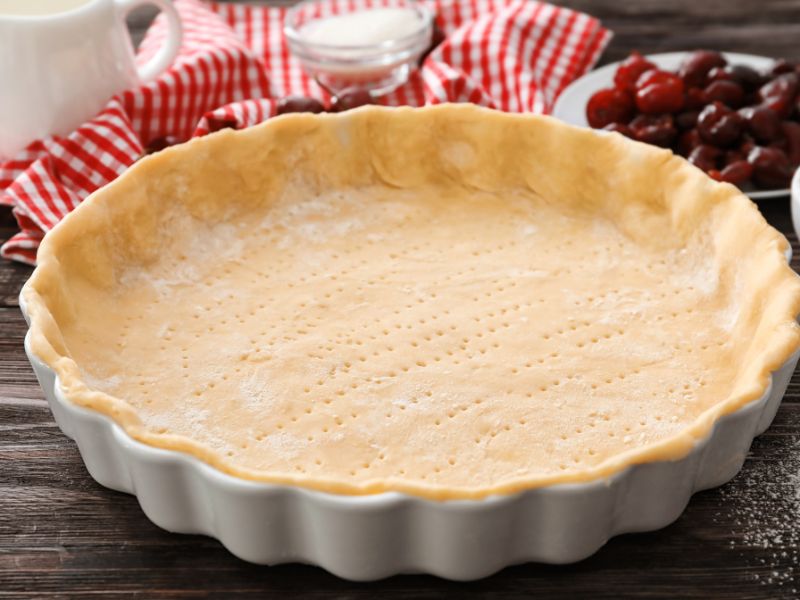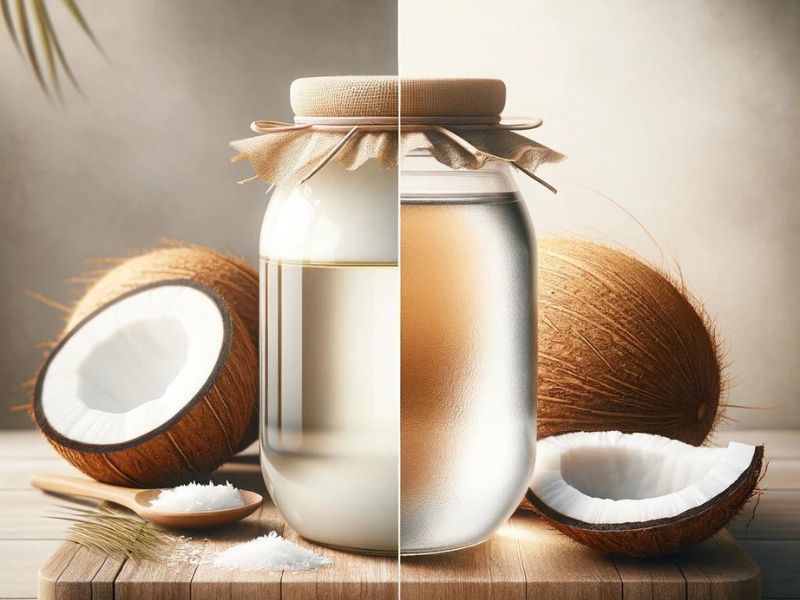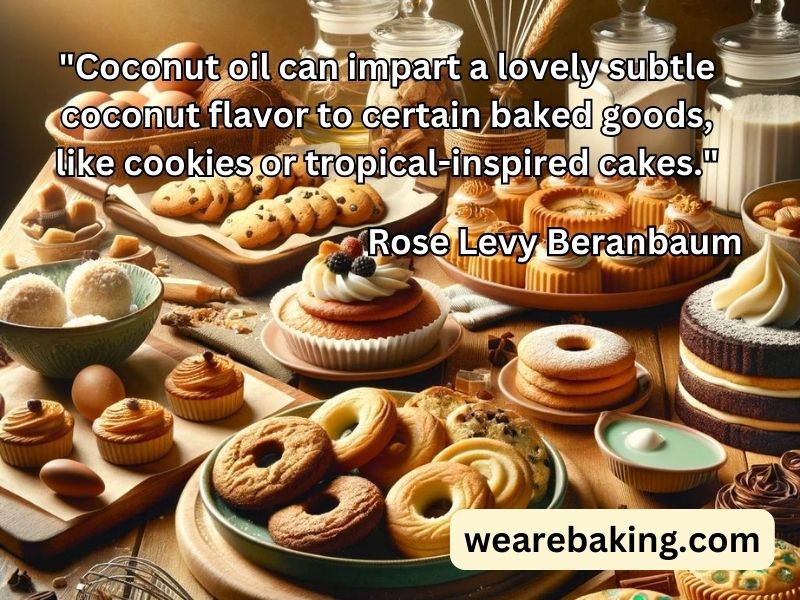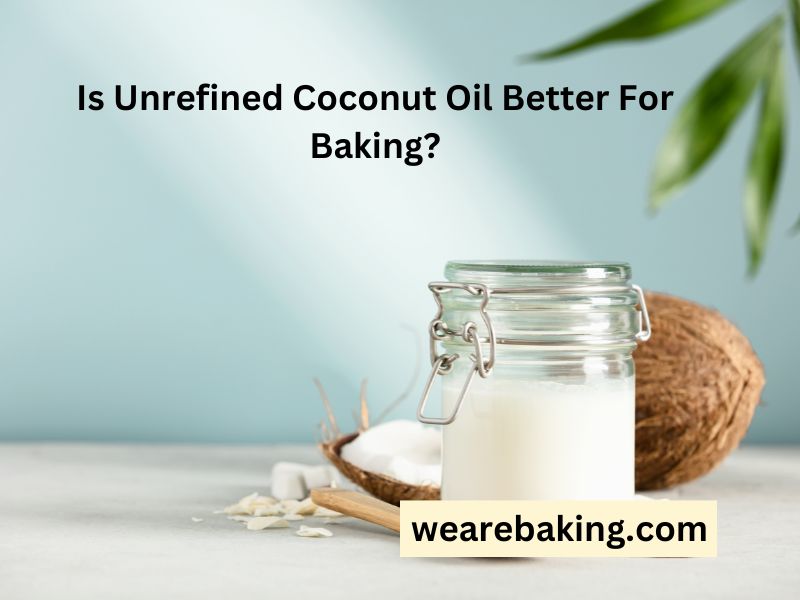Unrefined coconut oil brings an intense coconut flavor and aroma, making it ideal for baked goods where you want coconut to be the dominant taste. Meanwhile, refined coconut oil has a subtle coconut essence and neutral flavor profile along with a higher smoke point. This flexibility makes refined coconut oil especially useful for all kinds of baked goods, from cookies to cakes and more.
Affiliate Disclosure: Some of the links below are affiliate links, meaning at NO additional cost to you, I may earn a small commission if you click through and make a purchase. Full Disclosure
🥥 Coconut Oil Showdown: Refined vs. Unrefined 🌴 |
||
|---|---|---|
| Feature | Refined Coconut Oil | Unrefined Coconut Oil |
| Processing Method | Refined, bleached and deodorized | Cold pressed, unrefined |
| Flavor | Subtle, neutral | Robust coconut flavor |
| Aroma | Light coconut aroma | Strong coconut scent |
| Smoke Point | 400°F (204°C) | 350°F (177°C) |
| Benefits | Versatile for baking and cooking, ideal for those avoiding a strong coconut taste | Provides coconut essence and tender texture in baking |
| Drawbacks | Lacks coconut flavor for some recipes | Lower smoke point limits high-heat methods |
| Brought to You by “wearebaking.com” | ||
Coconut Oil: Refined vs. Unrefined
When it comes to baking, both refined and unrefined coconut oil can be used with delicious results. However, each type of oil has different properties that influence flavor and texture.
The choice between refined and unrefined can be confusing. Both come from coconut meat and offer delicious flavor – but they’re processed differently. So, how do you choose between refined and unrefined when planning your next baking project?
Refined coconut oil goes through extra filtration and heating to remove much of that signature coconut aroma and taste. The result is a more neutral-flavored oil with a light coconut aftertaste. Refined oil also has a higher smoke point, around 400°F.
Meanwhile, unrefined coconut oil skips that process to keep its rich coconut flavor and nutrients. You’ll notice the coconut scent as soon as you open the jar! Unrefined oil has a lower smoke point around 350°F.
So refined gives you flexibility and neutrality. While unrefined brings bolder coconut traits plus added moisture for tender baked goods. Both shine in the right recipes!
Unrefined Coconut Oil

When you want your baked goods to flaunt that tropical coconut flavor, unrefined coconut oil is a great choice. In your recipes, unrefined coconut oil adds a delicious depth of flavor and slight sweetness that takes bars, cookies, cakes, and breads over the top.
Since the nutty and vanilla undertones complement the coconut so nicely, you’ll find you don’t have to add any additional sweeteners. A little goes a long way!
Unrefined does have a lower smoke point which means you should avoid frying methods. But it still performs great for baking goodies at moderate temperatures. And with that extra bit of moisture from the virgin oil, you’ll find that treats like coconut macaroons and shortbread turn out incredibly tender.
Unrefined oil helps you create an incredible depth of flavor.
Refined Coconut Oil

When you want a more subtle coconut flavor that plays nice with other ingredients, refined coconut oil is a great baking choice. Since it goes through processing to remove much of the coconut scent and taste, refined coconut oil has a more delicate, neutral profile.
That neutral quality makes refined coconut oil a flexible baking staple. It blends into all types of batters and doughs perfectly without overpowering them. So treats like sugar cookies, pie dough, and even veggie muffins turn out delicious!
For dairy-free baking, refined coconut oil performs great as an animal butter substitute in things like frosting and shortbread. With just a hint of coconut flavor, it’s the neutral player that keeps your baking game strong!
Picking the Right Oil
When deciding which type of coconut oil to use, it helps to consider the flavor profile you’re aiming for as well as the ideal texture. Recipes that spotlight coconut tend to benefit more from unrefined oil so that flavor shines. Recipes where other flavors take center stage often do well with refined coconut oil, enhancing texture and moisture without adding or overpowering flavors.
For treats like coconut macaroons, coconut cake, or tropical fruit bars, go with unrefined oil to let the coconut flavors pop. The nutty richness paired with coconut sweetness takes these baked goods over the top. Plus, unrefined oil gives extra moisture for tender texture.
Meanwhile, refined coconut oil fits perfectly into recipes where coconut stays in the background. Delicate cookies like shortbread, sugar cookies, scones, and pie dough get a subtle flavor boost from refined without coconut dominating. No battling flavors!
You can also mix together refined and unrefined coconut oils in some baked goods recipes. The ratio you use depends on how strong you want the coconut flavor to be compared to other strong tastes.
For example, a carrot cake recipe might use 1/2 cup refined coconut oil and 1/4 cup unrefined oil. The unrefined oil allows some coconut flavor to come through, while the refined oil makes sure spices and carrots still stand out.
Experiment by blending different amounts of unrefined and refined oils in recipes until you find a combination you love. You might create the next signature flavor! Both types of coconut oil can play a role side-by-side.
🍪 Baking Recipe Oil Guide 🍰 |
||
|---|---|---|
| Baked Good | Best Oil Choice | Why |
| Coconut Macaroons | Unrefined | Bold coconut flavor |
| Sugar Cookies | Refined | Subtly enhances without overpowering |
| Pie Crust | Refined | Flaky with neutral taste |
| Carrot Cake | Mix of both | Balances flavors |
| Brought to You by “wearebaking.com” | ||
Beyond Baking
While most baking recipes spotlight refined or unrefined coconut oil well, you can also use them for cooking as well.
Unrefined coconut oil adds a touch of tropical flair and moisture to dishes like curries, stews, and stir fry. Its bold coconut flavor works well to enhance savory Thai or Indian cuisine. Just avoid direct high-heat sizzling.
Refined coconut oil’s high smoke point makes it the choice for sautéing and frying needs. Use it for crisping veggies, popping popcorn shrimp, searing meats, or whipping up flavorful sauces to pour over rice or roasted potatoes. The subtle coconut taste adds interest without being overpowering.
So bake with coconut oil, of course – but don’t forget to grab it for round two to cook up some savory food!
Bonus Tip: Experiment with Both Oils!

When it comes to coconut oil, don’t be afraid to try out both refined and unrefined varieties in your recipes. Experimentation lets you get familiar with how each oil influences factors like flavor, moisture, richness, and texture in your baked goods.
Play around with coconut ratios in your standard recipes and take notes. Would your classic chocolate chip cookie or lemon pie filling benefit from a stronger coconut flavor or a lighter coconut taste? Put both oils to the test!
Trying out unfamiliar ingredients helps you break out of your comfort zone. Mixing the familiar with something new, you may discover even tastier homemade treats
So forget the coconut oil brand loyalty and give both types a chance when baking your next baked goods. Taste the variety from light and airy to rich and nutty. A little trial and error makes the journey more delicious.
Frequently Asked Coconut Oil Questions
Using coconut oil in baking brings about all sorts of questions. From substitution ideas and storage methods to health implications
Can I substitute other oils for coconut oil in baking?
Yes, in some cases, you can substitute coconut oil with vegetable, olive, avocado, or other neutral-tasting oils. You may need to adjust the liquid amounts in the recipe. Also, keep in mind variances in melting points and flavors.
What are some healthy baking alternatives to coconut oil?
Great alternatives include avocado oil and olive oil, which offer additional benefits like heart-healthy fats. Applesauce and banana purees work too. For drier bakes, try using nut butters like almond or sunflower seed butter.
How can I store coconut oil properly?
Keep jars of coconut oil sealed tightly at room temperature, away from light and heat, to maximize freshness. Refrigeration can help extend shelf life 1-2 years. Look for solidification and yellowing as signs oil has gone rancid. Discard at that point.

Key Learning Points:
- Both refined and unrefined coconut oil can be used in baking, but each has unique properties impacting flavor and texture.
- Unrefined coconut oil boasts a strong coconut taste and aroma, ideal for recipes where that flavor shines.
- Refined coconut oil is neutral-tasting and has a higher smoke point, making it versatile for various baking applications.
- Consider your recipe’s flavor profile and desired texture when choosing between the two.
As an Amazon Affiliate, I may earn a commission from qualifying purchases.
Have you used coconut oil in your baking? Please leave me a comment below
And As Always
Keep On Baking!
Taianne
Share the Love

I’m Taianne, the owner and operator behind We Are Baking. Baking my first cake at age 11 hooked me on creating sweet treats. Though my interest faded during childhood, it was rekindled when I married my apple pie-loving husband. I love trying new recipes, tweaking classics, and helping others learn the science and art of baking. I started We Are Baking to share tips, tricks, and favorite recipes I’ve discovered over the years. When not in the kitchen, I enjoy spending time with family and friends. My goal is to inspire others to embrace their creativity through baking. Feel free to contact me with any questions!
Taianne@wearebaking.com

